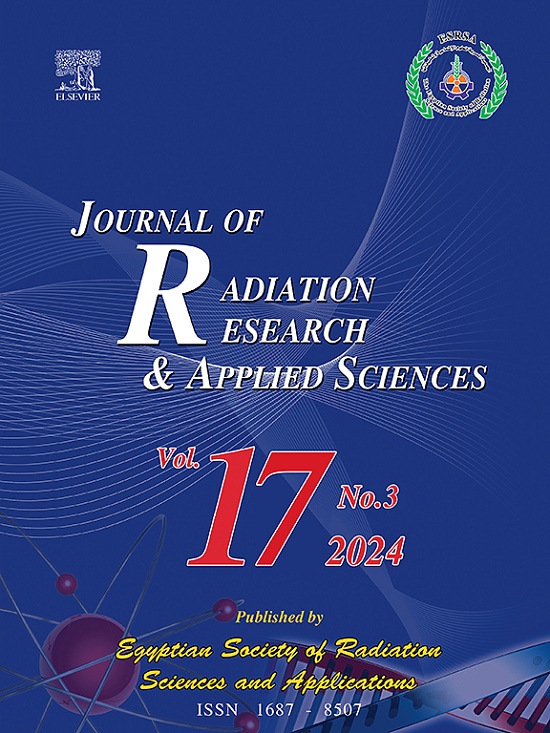A numerical analysis of magnetohydrodynamic water-based AA7072 nanofluid flow over a permeable stretching surface with slip conditions
IF 1.7
4区 综合性期刊
Q2 MULTIDISCIPLINARY SCIENCES
Journal of Radiation Research and Applied Sciences
Pub Date : 2025-02-26
DOI:10.1016/j.jrras.2025.101356
引用次数: 0
Abstract
The nanofluid flow on a permeable stretching sheet with slip conditions has significant applications in various technological and industrial domains, especially those involving water-based AA7072 nanofluid flow. This nanofluid is ideal for increasing cooling systems in higher-performance computing and microelectronics. It can optimize processes like hyperthermia treatments and drug delivery due to its effective thermal management properties. The water-based AA7072 nanofluid is important for enhancing the efficiency of nuclear reaction cooling, solar collectors, and geothermal energy extraction. This work investigates nanofluid flow on a permeable stretching sheet with slip boundary conditions. The impact of the magnetic field is used in the normal direction of fluid motion. The influence of Joule heating, heat source viscous dissipation, and activation energy is also used in the work. The leading equations have changed to dimensionless notation and have been evaluated through the bvp4c technique. It has been highlighted in this study that, with growth in slip factor for velocity along the x-direction and y-direction there is a decrease in both primary and secondary velocities as well as in temperature and concentration distributions. Growth in the porosity factor causes a reduction in primary velocity and augmentation in secondary velocity. Primary velocity has declined while secondary velocity and thermal distribution have amplified with progression in magnetic factor and concentration of nanoparticles. Growth in Brownian motion has amplified thermal distribution while retarded concentration distribution. Thermal distribution has augmented with growth in Eckert number and heat source factor. Concentration panels have weakened with growth in chemically reactive factor and Schmidt number while augmented with an escalation in the activation energy factor.
磁流体力学水基AA7072纳米流体在具有滑移条件的可渗透拉伸表面上流动的数值分析
纳米流体在具有滑移条件的可渗透拉伸片上的流动在各个技术和工业领域,特别是涉及水基AA7072纳米流体流动的领域具有重要的应用价值。这种纳米流体是在高性能计算和微电子中增加冷却系统的理想选择。由于其有效的热管理特性,它可以优化热疗和药物输送等过程。水基AA7072纳米流体对于提高核反应冷却、太阳能集热器和地热能提取的效率具有重要意义。本文研究了纳米流体在具有滑移边界条件的可渗透拉伸片上的流动。磁场的冲击作用在流体运动的法向上。焦耳加热、热源粘滞耗散和活化能的影响也被应用到工作中。前导方程已改为无因次符号,并已通过bvp4c技术进行了评估。本研究强调,随着沿x方向和y方向速度滑移系数的增大,初级速度和次级速度以及温度和浓度分布都会减小。孔隙度因子的增大导致初级速度的降低和次级速度的增加。随着磁性因子和纳米颗粒浓度的增加,初级速度减小,次级速度和热分布增大。布朗运动的增长放大了热分布,减慢了浓度分布。热分布随埃克特数和热源因子的增大而增大。浓度面板随着化学反应因子和施密特数的增加而减弱,而随着活化能因子的增加而增强。
本文章由计算机程序翻译,如有差异,请以英文原文为准。
求助全文
约1分钟内获得全文
求助全文
来源期刊

Journal of Radiation Research and Applied Sciences
MULTIDISCIPLINARY SCIENCES-
自引率
5.90%
发文量
130
审稿时长
16 weeks
期刊介绍:
Journal of Radiation Research and Applied Sciences provides a high quality medium for the publication of substantial, original and scientific and technological papers on the development and applications of nuclear, radiation and isotopes in biology, medicine, drugs, biochemistry, microbiology, agriculture, entomology, food technology, chemistry, physics, solid states, engineering, environmental and applied sciences.
 求助内容:
求助内容: 应助结果提醒方式:
应助结果提醒方式:


